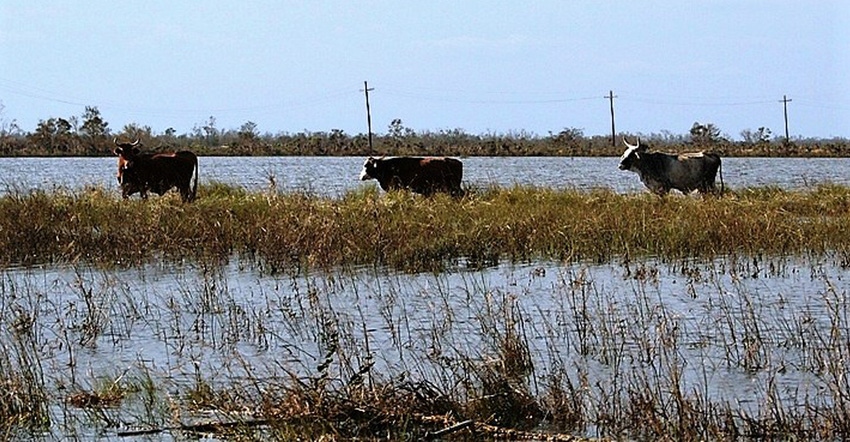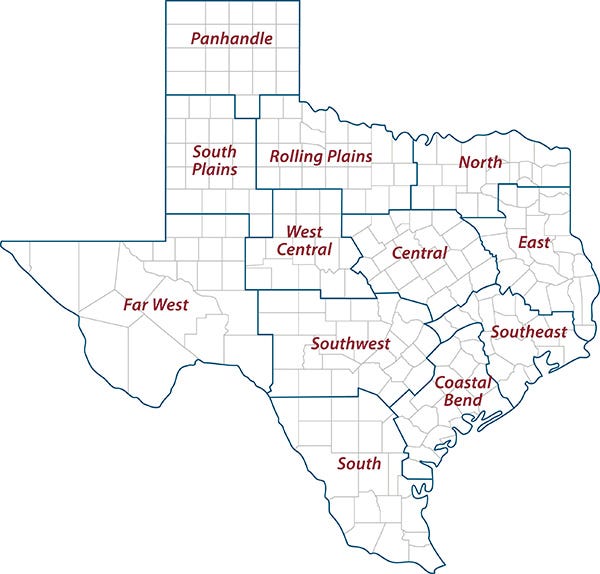
Tropical Storm Barry didn’t create major problems for Texans, but storm season is just getting underway, said the Texas State Climatologist.
Dr. John Nielsen-Gammon, College Station, said southeastern parts of the state received up to 5 inches of rain, but Barry, for the most part, avoided Texas. However, he added, the annual hurricane season typically ramps up in July to mid-August.
“It’s early in the season still,” he said.
There are two types of storms/hurricanes – tropical, which originate farther southward in the Atlantic; and storms that originate further north such as in the Gulf of Mexico’s warmer waters, Nielsen-Gammon said. Storms like Barry are triggered by upper-level disturbances and convection that can occur when they move over warmer waters in the Gulf of Mexico.
“June and early July typically kick off the hurricane season with these types of storms forming in the Gulf of Mexico,” he said. “Later in the season, storms are more common and form in the Caribbean or farther south in the Atlantic.”
About 15 percent of U.S. landfalling hurricanes are early season hurricanes, Nielsen-Gammon said.
There were four hurricanes and seven other tropical storms in 2015, the last time there was an El Niño system and warmer tropical waters as there is this year, Nielsen-Gammon said. Tropical Storm Bill was the only storm to make landfall along the Gulf of Mexico that year. It delivered almost 14 inches of rain near Port Lavaca and flooding throughout parts of Texas and Oklahoma, and two people died as a result of floodwaters.
Storm forecasts don’t predict anything forming in the near future, he said, and long-term outlooks for the tracks of specific tropical storms and hurricanes are impossible to predict.
Overall, the hurricane season is expected to be close to average. Meanwhile, the seasonal forecast indicates below-normal precipitation across the state for the next few weeks.
Nielsen-Gammon said most of the state west of Interstate 45 has been fairly dry for more than a month. Eastern parts of the state, including Houston and Dallas, received up to three times the normal rainfall during that time.
AgriLife Extension district reporters compiled the following summaries:

CENTRAL: Scattered rains delivered zero to 4.25 inches as the district settled into the normal summertime weather pattern of hot and dry. Crops recovered from early problems. Cotton was progressing well and under irrigation where available. Dry conditions allowed fieldwork and hay baling activities to get into full swing. Hayfields had produced around two to three cuttings of hay, bringing producers’ stocks back up. Pasture and rangeland conditions looked good but were slowly deteriorating with high temperatures and a lack of rainfall. Cattle looked good. Nearly all counties reported adequate moisture levels and good overall crop conditions.
ROLLING PLAINS: Most of the district experienced hot, dry weather, while some areas received up to 3 inches of rain. Pastures and rangelands were in good to fair condition. Cotton fields were in good condition but were behind schedule overall. Producers reported issues with grasshoppers. There were also parasite problems in sheep and goats.
COASTAL BEND: Hot, humid days with no rain were reported. Sorghum was coloring fast and was 80% harvested in the southern end of the district. Corn was drying down fast, and harvest was also underway in many areas with exceptional yields being reported. However, in other areas corn condition estimates were lowered due to a lack of rainfall. Cotton was progressing well with bolls opening. Soybeans needed rain. Rice was heading out. Good quality hay was being rolled up. Pastures and rangelands were in good condition but needed some rainfall. Livestock were in excellent condition.
EAST: A few areas received light rains. Hay production was in full swing across the district with conditions drying out. Cherokee County reported higher-than-normal volumes of hay being produced. Harrison County hay producers were at least four weeks behind due to weather. Pasture and rangeland conditions were good to excellent. Subsoil and topsoil moisture levels were adequate. Peas, melons and peaches were harvested. Gardens were progressing and producing well. Some areas were showing signs of moisture stress. Producers attributed the stress to plants not establishing deeper root systems due to high moisture levels throughout the season. Livestock were doing well. Wild pigs caused heavy damage to vegetable crops, pastures and hay meadows. Multiple counties reported trouble with Bermuda grass stem maggots, grasshoppers and armyworms.
SOUTH PLAINS: Subsoil and topsoil moisture levels were good to adequate. Producers continued to run irrigation amid warmer temperatures. Rain wasreceived in various locations in the county, but hot conditions continued to dry things out. Cotton was three weeks behind schedule. Most cotton fields were in the three-to-seven first position squares with blooms still two to three weeks away. Many fields showed signs they will bloom with nine nodes above the white flower. A storm negatively affected some cotton fields. There were reports of some farmers losing up to 1,500 acres to hail and high winds in the western parts of the district. Sorghum and corn producers took losses as well. Complete damage estimates were not yet totaled. Peanuts looked good and were rapidly developing. Cattle, pastures and rangelands were in good condition.
PANHANDLE: Area producers had a productive week and worked around scattered showers that shut down fieldwork. Wheat harvest was close to complete with a few straggling fields. Corn production came along well with the 90-plus-degree temperatures, but most corn was still behind on growth with no fields close to tassel. Grain sorghum fields were also behind schedule. Cotton acres were struggling, and many producers wondered what to do with the crop since it was so late. Rangeland and pasture conditions were above average, and cattle were in excellent condition.
NORTH: Soil moisture was mostly adequate across the district with a few counties reporting short conditions. High winds and temperatures were drying soils out. Scattered showers delivered up to three-quarters of an inch of rain. Pastures and hayfields looked great for the middle of July. Warmer temperatures and a little rain here and there the last several weeks made for excellent hay and forage production. Producers were still cutting and baling, though production had slowed compared to previous reporting periods. Producers were making multiple cuttings on Coastal Bermuda grass and Klein grass pastures. Corn fields looked decent with some fields having long ears that filled out well, while other fields that stayed wetter longer were not as good. The corn harvest was expected to be later than normal and should start around Aug. 1. Sorghum maturation was strung out as well with a small percent headed and coloring, some just now booting and most acres flowering. Early soybeans looked good and were loaded with pods. Some farmers were following wheat with double-cropped soybeans. Cattle were gaining weight on good forage. There were a lot of stocker calves on summer pastures, and they were doing well. There were signs of armyworms over the past month, but none since rains stopped. Producers were preparing for another generation of armyworms to emerge behind Tropical Storm Barry. Most farmers sprayed for sorghum midge and stinkbugs. There were some reports of grasshoppers.
FAR WEST: Temperature highs were in the 100s with lows in the 70s. Conditions were dry, hot and windy with trace amounts of rain. Early planted sorghum started to turn color. Corn was denting, and most irrigation was turned off. A few cotton fields were beginning to bloom and will need rain soon. Dryland cotton was holding on but will also need a good rain before it begins to bloom. Watermelon harvest was in full swing. Producers were putting out fertilizer on cotton and pecans. Pecan trees needed water. Producers reported good pecan cluster sets in most trees. High temperatures were stressing all crops, pastures and livestock. Rangelands were beginning to dry and turn from a dull green to a slight brown. Several fires were reported. Cows received supplemental feed. Cow/calf producers reported weaning of early spring calves was complete and have introduced feed into their ration to precondition calves prior to shipment. Shipping of subpar ewes and lambs finished up.
WEST CENTRAL: Cotton grew well with warm temperatures and sunshine. Some areas received rain but not enough to help anything. Grain sorghum was maturing. Pastures were in good shape. The pecan crop was developing nicely with 3-5 nuts per cluster. Stocker steers were $3-$5 higher per hundredweight, and stocker heifers were $5 higher. Feeder steers were $2-$5 higher per hundredweight, while feeder heifers were a full $3 higher. Packer cows and bulls, pairs and bred cows were steady.
SOUTHEAST: Chambers County received heavy rain from the tail end of Tropical Storm Barry. In Walker County, hay producers attempted to harvest hay in between showers and downpours. Several dry days helped, depending on the location. Hay pastures were growing fast and an above-average cutting was expected. Brazos County experienced hot conditions. In Jefferson County, Barry’s effects were minimal. Some rain fell over the weekend near the Sabine River, but it did not affect rice fields. Rice was progressing fast from hot weather.
SOUTHWEST: No rain was reported. Some counties reported declining rangeland and pasture conditions due to high temperatures and no rain. Conditions helped dry out fields previously inaccessible due to flooding. Cotton looked good in most counties. Wildlife and livestock were in good shape.
SOUTH: The northern part of the district reported hot weather conditions with short to adequate soil moisture levels. Conditions were hot and dry in the western parts of the district with adequate to very short soil moisture levels. Eastern parts of the district were hot and dry as well with short to very short soil moisture. Wet weather conditions were reported in the southernmost part of the district with short soil moisture levels. Starr County reported scattered showers with trace amounts up to 2 inches of rain. Maverick County reported temperatures near 100 degrees. Grain sorghum and corn fields looked good in Atascosa County and were progressing well in Zavala County. Corn and sorghum harvests were underway in Frio and Jim Wells counties. Sorghum harvest was almost complete in Kleberg and Kennedy counties with preliminary yields of 4,800 pounds per acre. Corn harvest was nearing. Hay was cut and baled, but rain would benefit most pastures, cotton and peanuts. Peanut fields were starting to peg and were under irrigation. Cotton was also under irrigation. Cotton bolls were opening in Jim Wells, Kennedy and Kleberg counties. Haygrazer was being cut and baled. Pasture and range conditions continued to decline in most areas due to hot temperatures and no rainfall. McMullen County reported spotty rains helped maintain rangeland and pasture conditions. Supplemental feeding may take place in the next 10-15 days in Zavala County if there is no subsequent rainfall. Some producers continued to haul water and provide supplemental feed, while others began to cull herd numbers. Row crops in Jim Wells County were showing signs of moisture stress.
Source: is AgriLife TODAY, which is solely responsible for the information provided and is wholly owned by the source. Informa Business Media and all its subsidiaries are not responsible for any of the content contained in this information asset.
About the Author(s)
You May Also Like




